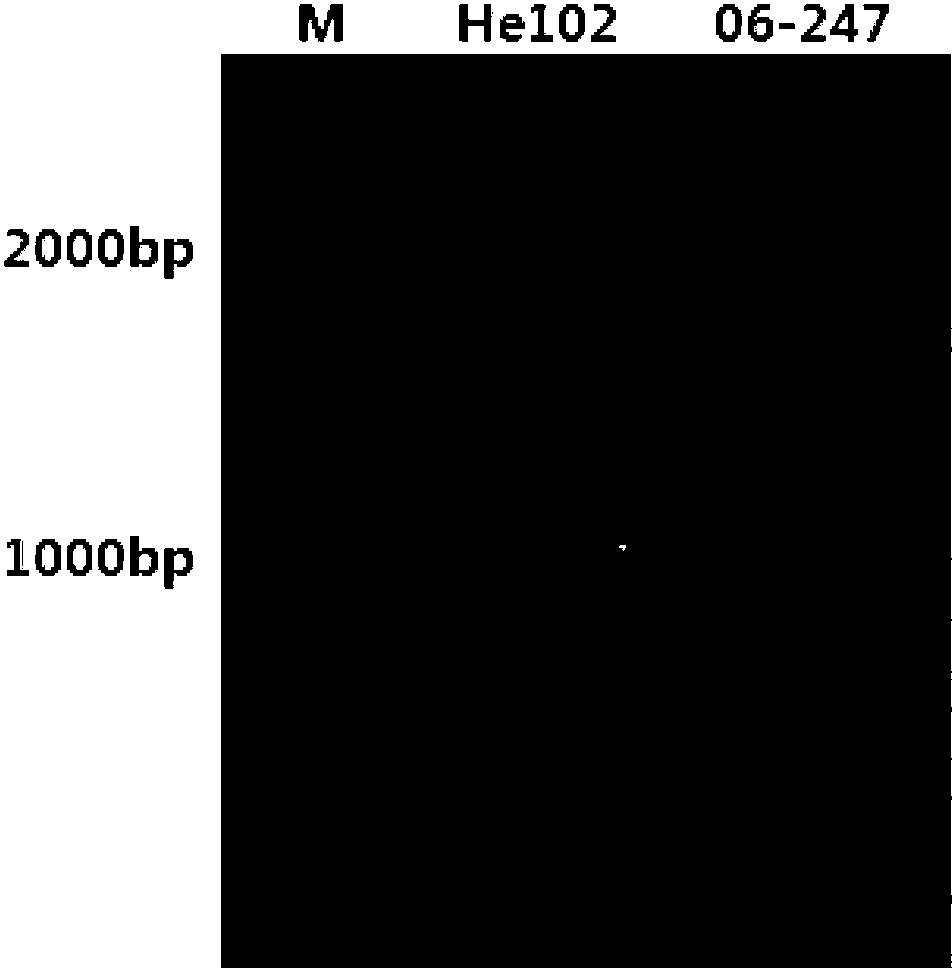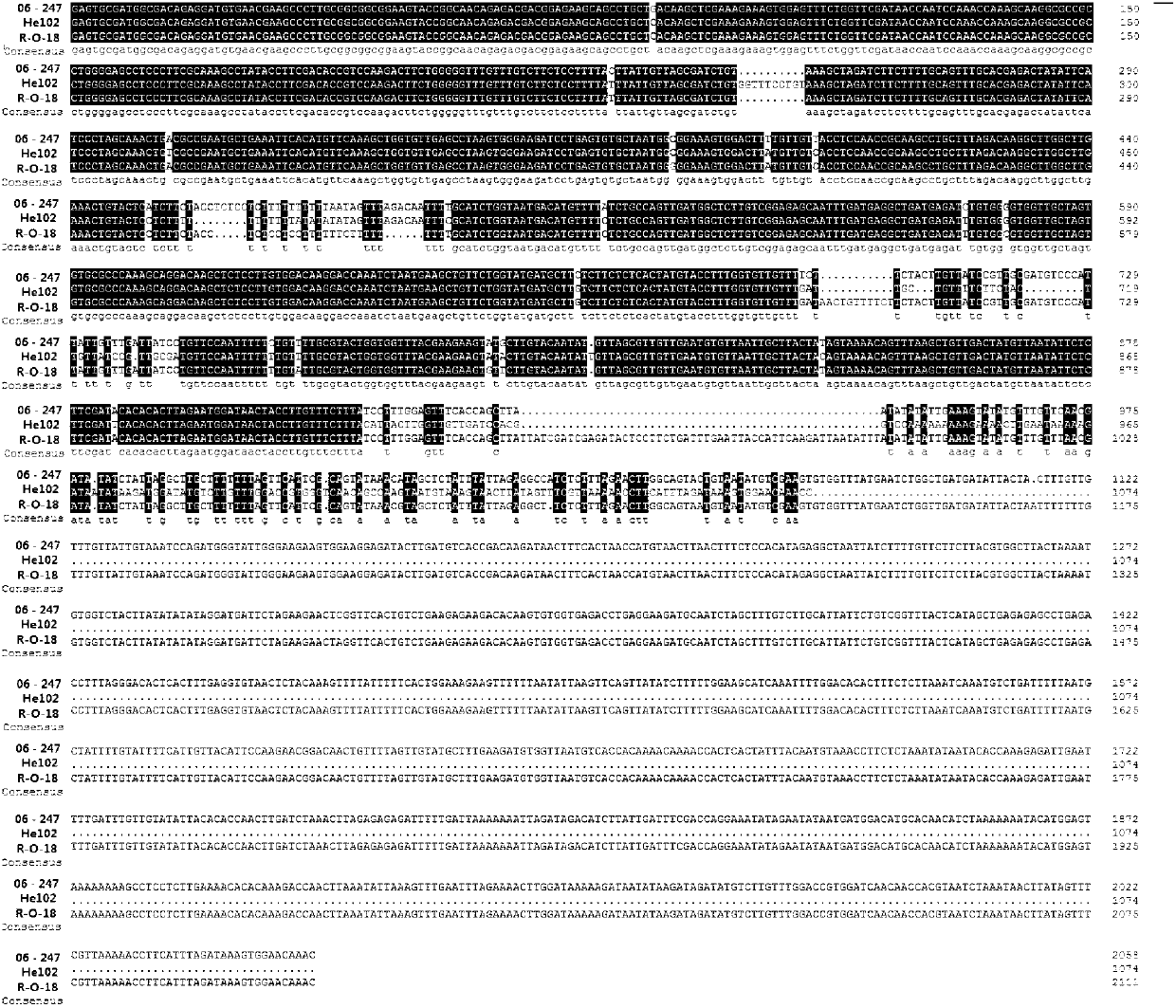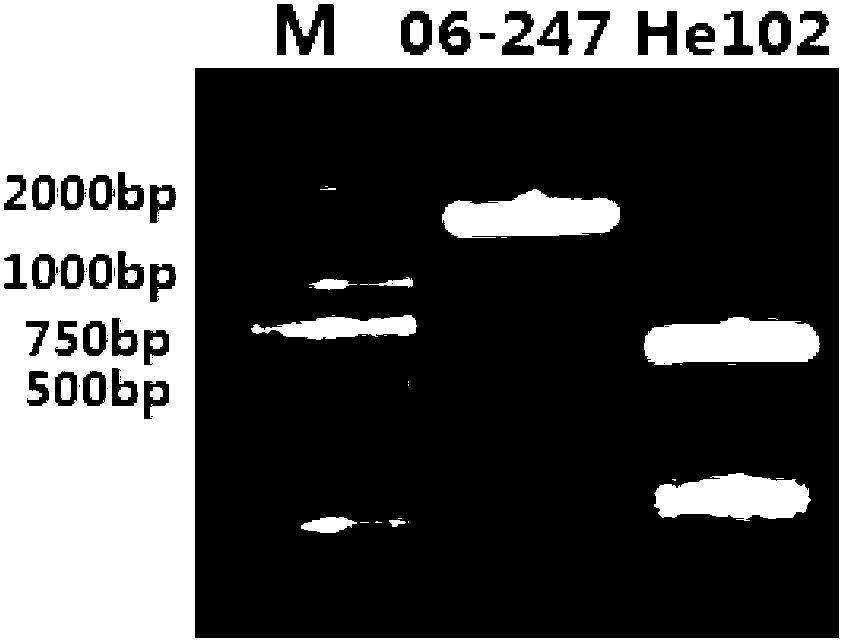Specific molecular marker of Brassica rapa L.ssp pekinensis eIF (iso) 4E.a locus large fragment deletion mutation and application thereof
A technology of asm-iso4e.a, deletion mutation, applied in the direction of DNA / RNA fragments, recombinant DNA technology, etc., to achieve the effect of improving screening efficiency, stable results, and easy operation
- Summary
- Abstract
- Description
- Claims
- Application Information
AI Technical Summary
Problems solved by technology
Method used
Image
Examples
Embodiment 1
[0029] Example 1. Cloning of eIF4E.a in different Chinese cabbage inbred lines
[0030] 1.1 Genomic DNA extraction from Chinese cabbage
[0031] (1) Put the leaves of Chinese cabbage seedlings into a liquid nitrogen pre-cooled mortar, and grind them into powder in liquid nitrogen;
[0032] (2) After the liquid nitrogen evaporates to dryness, transfer it to a 2ml centrifuge tube immediately, add about 0.6ml of CTAB extract preheated to 65°C for every 100mg of material, after melting, vigorously shake and mix the sample, place it in a 65°C water bath for 40- 60 minutes to lyse the cells;
[0033] (3) After the lysis is complete, take out the sample and let it cool down to room temperature completely. Add an equal volume of chloroform (chloroform), gently invert to mix, and place at room temperature for 10 minutes;
[0034] (4) Centrifuge at 12000 rpm for 15 minutes at room temperature;
[0035] (5) Use a pipette to carefully suck out the upper aqueous phase, add it to a new ...
Embodiment 2
[0053] Example 2 Development of co-dominant ASM markers
[0054] 2.1 Primer design
[0055] Carefully compare the genome sequences of BraeIF(iso)4E.a (wild type) and BraeIF(iso)4e.a (mutant), the difference is mainly the deletion of the 3' end of the latter. For such differences, the upstream of the deletion region is conserved A forward primer (as shown in SEQ ID NO.3) is designed for the region, and a reverse primer Rd is used as a primer for genome sequence amplification (as shown in SEQ ID NO.4). The primers were synthesized by Jinan Boshang Biotechnology Co., Ltd.
[0056] 2.2 Acquisition of ASM mark:
[0057] (1) Amplification in He102 and 06-247 by combination of forward and reverse primers: The preparation of PCR reaction solution and amplification conditions are as described in item (2) of 1.2.
[0058] (2) The detection of the amplification result is as described in item (3) of 1.2.
[0059] (3) Amplification results such as image 3 As shown, the two primers ca...
Embodiment 3
[0060] Example 3 Identification of Individual Plants in Backcross Population (He102×06-247)×He102 by ASM Markers
[0061] (1) Genomic DNA extraction from different individual plants of the backcross population was as described in 1.1.
[0062] (2) PCR amplification: The preparation and amplification conditions of the PCR reaction solution are as described in item (2) of 1.2.
[0063] (3) Detection of PCR products is as described in item (3) of 1.2. Test results such as Figure 4 As shown, 1-21 is 21 parts of Chinese cabbage materials, M is DNA molecular weight standard DL2000. As can be seen from the figure, Figure 4 1-4 in A are heterozygous, 5-10 are mutants, Figure 4 11-21 in B is wild type.
[0064]
[0065]
[0066]
[0067]
[0068]
[0069]
PUM
 Login to View More
Login to View More Abstract
Description
Claims
Application Information
 Login to View More
Login to View More - R&D
- Intellectual Property
- Life Sciences
- Materials
- Tech Scout
- Unparalleled Data Quality
- Higher Quality Content
- 60% Fewer Hallucinations
Browse by: Latest US Patents, China's latest patents, Technical Efficacy Thesaurus, Application Domain, Technology Topic, Popular Technical Reports.
© 2025 PatSnap. All rights reserved.Legal|Privacy policy|Modern Slavery Act Transparency Statement|Sitemap|About US| Contact US: help@patsnap.com



